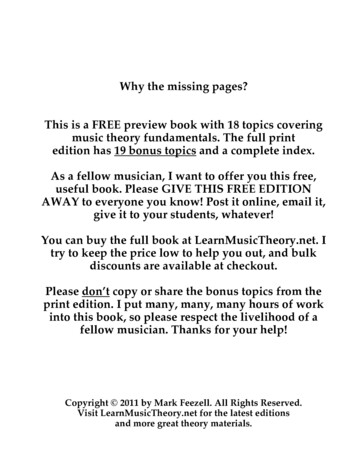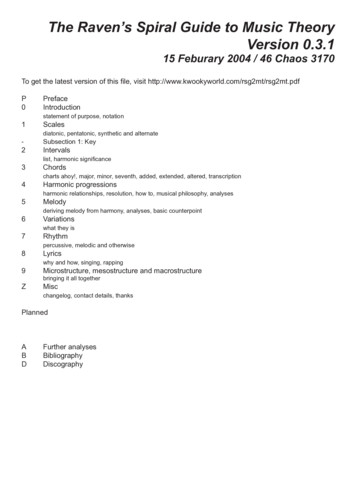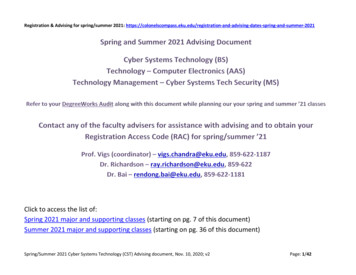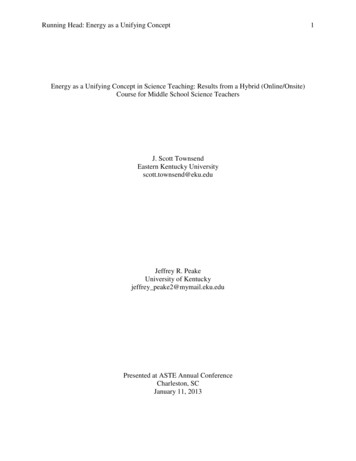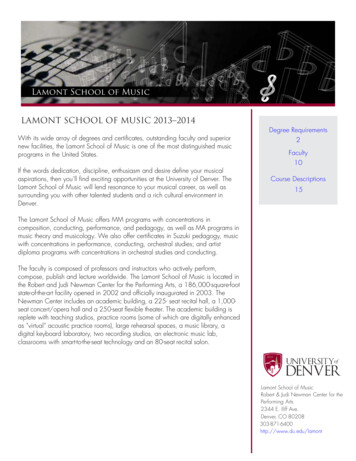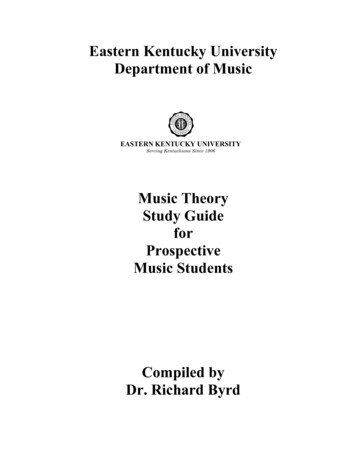
Transcription
Eastern Kentucky UniversityDepartment of MusicEASTERN KENTUCKY UNIVERSITYServing Kentuckians Since 1906Music TheoryStudy GuideforProspectiveMusic StudentsCompiled byDr. Richard Byrd
TO THE PROSPECTIVE MUSIC STUDENT:We are excited to know that you are considering Eastern Kentucky University as your choice formusical training. While preparing to enter your particular field of interest in music, whether it be inteaching, performing, composition, arranging, administration, business, instrument design, instrumentrepair, therapy, or in any other music-related area, every music student should have a basicunderstanding of music theory. With that in mind, we believe that it is to your advantage to prepareyourself before you begin your college studies. Before you begin your musical studies at EKU, youwill need to take a theory diagnostic exam to help determine your placement in the theory program.The EKU music theory and composition program is one of excellence. The music theory andcomposition faculty are nationally recognized educators, composers, and performers. Many of ourstudents have participlated in national conferences and composition symposiums. After completingan undergraduate music degree, many of our students attain graduate degrees at prestigious collegesand universities, while others serve as music educators, work in the music industry, and performprofessionally.The Bachelor of Music Theory and Composition degree (B.M.) is designed to prepare students forcareer in teaching at the college and university level. This degree also prepares students tosuccessfully enter a graduate program in music theory or composition. At EKU students will beexposed to a wide variety of compositional styles, and will have the opportunity to compose musicfor a variety of instrumental and vocal combinations. Advanced study on piano is an asset. Studentsare requried to declare a major instrument for additional applied study. Music theory andcomposition majors are required to give an additional recital of their original compositions as well asa theory paper presentation. EKU currently uses the Kostka and Payne theory text and workbook,Tonal Harmony, and the Berkowitz musicianship text, A New Approach to Sight Singing, for theirfour-semester sequence of music theory courses.Our music theory and composition faculty have diverse backgrounds in music theory andcomposition. They have written articles for professional journals, made presentations at professionalconferences, composed music for various organizations, and had several works published.Additionally, each member of our music theory and composition faculty has an extensive backgroundin performance and performs professionally.EKU Music Theory Faculty:Dr. Thomas Couvillon, Ph.D.E-mail: Thomas.Couvillon@eku.eduWeb page: Thomas CouvillonDr. Richard Byrd, Ph.D.E-mail: Rich.Byrd@eku.eduWeb page: Richard ByrdDr. Kristen Kean, DMA, fluteE-mail: Kristen.Kean@eku.eduWeb page: Kristen KeanDr. Nathan Jasinski, DMA, celloE-mail: Nathan.Jasinski@eku.eduWeb page: Nathanael Jasinski
About our Music Department:The EKU Department of Music provides aspiring students with the training and education they needto succeed as professionals in the field of music. Students learn the historical, stylistic, and theoreticalfundamentals of music and apply this knowledge through performance and scholarship. EKU musicstudents have the unique opportunity to perform with award winning ensembles that are regularlyinvited to perform at national and international festivals and competitions. EKU music students studywith nationally recognized, award winning faculty, guest artists, and clinicians. The degree programsoffered by the EKU Department of Music are accredited by The National Association of Schools ofMusic, the Southern Association of Colleges and Schools, and the National Council for theAccreditation of Teacher Education.Our music program offers several undergraduate degree options including the Bachelor of Music inMusic Education, Bachelor of Music with an Emphasis in Music Industry, Music Performance, andMusic Theory and Composition. In addition to preparing students for careers in music, the disciplineacquired in meeting the demands of musical performance may also serve as an excellent backgroundfor persons desiring to pursue careers in other fields. The Department offers a music minor consistingof piano, music theory, music history, and electives. Other degree options including currentcurriculum guidelines are also available upon request.The music program also offers graduate degree options in Performance, Choral Conducting,Theory/Composition, Music Education, and Instrumental Conducting. All applicants must beaccepted by the Graduate School and the EKU Department of Music. All MM candidates mustregister for the Music Theory Entrance Exam. Applicants need to contact Dr. Thomas Couvillonto schedule this exam and are also encouraged to download the Study Guide for the EKU GraduateEntrance Theory Examination.Please feel free to contact our Music Department at EKU to answer any questions you may haveabout our music programs. We invite you to visit our web site at www.music.eku.edu to acquaintyourself with our university, music programs, and faculty.How to use this study guide:This guide is designed to be a self-help tutorial to help prepare the prospective music student for theirfirst semester of theory at EKU. Through diligent study and careful practicing of the materials in thisguide you will have a solid foundation upon which you can strengthen your music skills in yourdesired music program. Please study each lesson thoroughly before proceeding to the studyquestions. All of the answers to the questions are provided in the back so that you can check youranswers. Be sure not to neglect the important lesson on ear training and sight singing.If you have questions about the material or if you do not understand the material in any the lessons,please refer to the selected bibliography in the back of this study guide. The titles listed in thisbibliography are excellent resources to help you further understand the concepts and principles taughtin this study guide. Many of these sources are texts that are currently being used by many college anduniversity music theory programs.
Lesson One: Musical SymbolsStaff—a set of five parallel horizontal lines and four intervening spaces that each representsa musical pitch.Grand staff—the combination of the treble and bass clefs joined together by a brace.Middle C—the name given to the pitch C which is near the middle of the piano keyboard.Bar line—a symbol used to organize music into groupings or patterns.Double bar line—a symbol used to mark the end of a composition or the end of a majorsection of a composition.
Ledger lines—short lines equidistant from each other used to extend the staff above orbelow the written staff.Clef—indicates where the pitch letter names are placed on the staff.Treble clef—also called the G clef, it designates the pitch g with a lower loop.Bass clef—also called the F clef, it designates the pitch f with two dots.Alto clef—a specific kind of C clef, it designates the Middle C pitch with an indention.Tenor clef—a specific kind of C clef, it designates the Middle C pitch with an indention.(Middle C is circled on each of the scales above.)Accidentals—chromatic alterations placed directly before the affected note and on the sameline or space as the note head (flat, sharp, double flat, double sharp, double flat, natural). Aflat lowers the pitch by one half step and a sharp raises the pitch by one half step. A doubleflat lowers the pitch by one whole step and a double sharp raises the pitch by one whole step.Note: It is important to make sure that you carefully notate each accidental so that themiddle of each accidental is centered on either the line or the space that it is marking.
Lesson One: Musical SymbolsPractice Questions1) Write one of each of the four clefs (treble, bass, alto, tenor) on the staff below.2) Write one of each accidental (flat, sharp, double flat, double sharp, natural) on the staffbelow.3) Identify the following pitches in various clefs by placing the correct pitch letter namebelow each pitch.4) Notate the requested pitches in the various clefs on the staff below.
Lesson Two: Key Signatures & Scale Degree NamesKey signature—accidentals written at the beginning of a composition (which can bechanged throughout the work) used to designate the key or tonality of a work.The order of flats is always: Bb, Eb, Ab, Db, Gb, Cb, FbThe order of sharps is always: F#, C#, G#, D#, A#, E#, B#vCircle of fifths—a diagram that illustrates the order of keys from the least to the greatestnumber of sharps (clockwise), and the least to the greatest number of flats (counterclockwise)
Note: It is best to just memorize both the major and minor key signatures! There arejust 15 major keys and 15 minor keys to learn for a total of 30 keys. While there are all sortsof clever methods to use to figure out the keys, it is in your best interest to have all the keysmemorized without using aids to “figure out the keys.” For example, when you see a keysignature of 4 sharps, 2 keys should IMMEDIATELY pop into your head—E major and c#minor. Using tricks and other clever methods will ultimately slow you down and potentiallyincrease the possiblity for error for more complicated theory problems.Note: The flats and sharps appear in the same order and pattern for key signatures written inboth the alto and tenor clefs).Relative Keys—the pair of major and minor keys that share the same key signature(e.g., G major and e minor both share the same key signature of 1 sharp).Parallel Keys—the pair of major and minor keys that share the same tonic note(e.g., C major and c minor both share the same c tonic pitch).Enharmonic Keys—the pair of major keys or pair of minor keys that share the same tonicnote in sound, but are written with a different key signature. (e.g., C# major and Db majorboth share the same tonic note in sound, but are written as 7 sharps and 5 flats respectively).Scale degree names—the traditional names given to the pitches of a scale as represented bytheir order.1st scale degree—tonic2nd scale degree—supertonic3rd scale degree—mediant4th scale degree—subdominant5th scale degree—dominant6th scale degree—submediant7th scale degree—leading tone or subtonic(The term leading tone is used for a raised 7th and the term subtonic is used for a lowered 7th)
Lesson Two: Key Signatures & Scale Degree NamesPractice Questions1) List the correct order of flats:2) List the correct order of sharps:3) What is the relative key of f minor?4) What is the relative key of B major?5) What is the parallel key of c# minor?6) What is the parallel key of Eb major?7) What is the enharmonic key of B major?8) What is the enharmonic key of F# major?9) Name the following keys with both a major and minor key for each key signature:10) Write the key signature for the requested keys:11) Name all 7 scale degrees in order:1 2 3 4 5 6 7
Lesson Three: Major and Minor ScalesHalf step—the shortest interval traditionally used in Western music, represented by twoadjacent keys on the piano (e.g., B—C, D—Eb, F—F#, etc.).Whole step—the combination of two half steps (e.g., G—A, B—C#, D—E, G#—A#).Major scale—a series of seven consecutive letter-name pitches found diatonically in itsmajor key with a pattern of whole steps and half steps as follows: W W H W W W H.Natural minor scale—a series of seven consecutive letter-name pitches found diatonicallyin its minor key with a pattern of whole steps and half steps as follows: W H W W H W W.Harmonic minor scale—a natural minor scale with the seventh scale degree raised one halfstep. Note that this scale creates the interval of an augmented 2nd between the 6th & 7th scaledegrees.Melodic minor scale—a natural minor scale with the sixth and seventh scale degrees raisedone half step in the ascending part of the scale, and a return (or re-lowering of the sixth andseventh scale degrees one half step) of the natural minor scale in the descending part of thescale.
While it is possible to spell all the major and minor scales using the patterns shown above, itis much more efficient (and easier) to use the key signatures that you memorized in theprevious lesson. Here are some examples of how this would work:To spell an E major scale:1) Write all the alphabet letters through one octave starting with an E on the staff usingwhatever clef is requested as follows: E, F, G, A, B, C, D, E.2) Apply (plug in) all the sharps or flats of the requested scale in front of all notes that apply.Since there are 4 sharps in the key of E major (F#, C#, G#, D#), place these four sharpsin front of the corresponding pitches as follows: E, F#, G#, A, B, C#, D#, E. Notice thatthis answer illustrates the W W H W W W H major scale pattern.To spell an e natural minor scale:1) Write all the alphabet letters through one octave starting with an E on the staff usingwhatever clef is requested as follows: E, F, G, A, B, C, D, E.2) Apply (plug in) all the sharps or flats of the requested scale in front of all notes that apply.Since there is 1 sharp in the key of E minor (F#), place that sharp in front of thecorresponding pitch as follows: E, F#, G, A, B, C, D, E. Notice that this answerillustrates the W H W W H W W natural minor scale pattern.To spell an e harmonic minor scale:1) Write all the alphabet letters through one octave starting with an E on the staff usingwhatever clef is requested as follows: E, F, G, A, B, C, D, E.2) Spell an e natural minor scale as shown above: E, F#, G, A, B, C, D, E3) Raise the 7th scale degree by changing D to a D# as follows: E, F#, G, A, B, C, D#, E.Note: Each letter of the alphabet must be represented, so be careful not to use enharmonicpitches that represent the same alphabet letter. For example, in e harmonic minor, youshould use a D# for the 7th scale degree rather than an Eb, otherwise there would be noalphabet letter represented for the letter D (e.g., E, F#, G, A, B, C, D#, E is correct and E, F#,G, A, B, C, Eb, E is incorrect).To spell an e melodic minor scale:1) Write all the alphabet letters through one octave starting with an E on the staff usingwhatever clef is requested as follows: E, F, G, A, B, C, D, E.2) Spell an e natural minor scale as shown above: E, F#, G, A, B, C, D, E3) Raise both the 6th and 7th scale degree by changing C to C# and D to a D# as follows:E, F#, G, A, B, C#, D#, E for the ascending part of the scale, and return the C# and D#back to its natural minor form as a C and D for the descending part of the scale:
Lesson Three: Major and Minor ScalesPractice Questions1) Spell the following requested scales without writing in the key signature by adding in theappropriate accidentals:Note: Be sure to write both the ascending and descending form of the melodic minorscale. All other scales can be spelled with just the ascending form.2) Write in the missing pitches in the blanks provided for the following requested scales:F# Major: F# G# B C# D# F#Eb harmonic minor: Eb F Ab Bb Cb EbAb Major: Ab Bb C Eb F AbB melodic minor: B D E F# A# B G F# E D BG# natural minor: G# B C# E F# G#3)4)5)6)7)What is the 6th scale degree of a B Major scale?What is the 3rd scale degree of a c# natural minor scale?What is the 7th scale degree of an f# harmonic minor scale?What is the ascending 6th scale degree of a c melodic minor scale?What is the descending 7th scale degree of a g melodic minor scale?
Lesson Four: IntervalsInterval—term used to measure the distance between two pitches. Each interval iscomprised of two parts—the interval quality and the interval size.Interval quality—describes the quality of the interval with the following descriptions:perfect (P), major (M), minor (m), diminished (o), and augmented ( ).Interval size—describes the size of the interval which is measured by how far apart the notesare on the staff with the following numbers: unisons, seconds, thirds, fourths, fifths, sixths,sevenths, and octaves.Melodic intervals—the distance measured horizontally between any two adjacent pitches.Harmonic intervals—the distance measured vertically between any two simultaneouslysounding pitches.Simple intervals—intervals that are smaller than an octave (including the octave).Compound intervals—intervals that are larger than an octave (e.g., m9 is a m2 plus anoctave, M10 is a M3 plus an octave, P11 is a P4 plus an octave, etc.)The term perfect (abbreviated P) is only used for unisons, 4ths, 5ths, and octaves (and theircompound intervals) as follows: P1, P4, P5, and P8. (P is NEVER used to describe 2nds,3rds, 6ths, or 7ths)The term major (abbreviated M) or minor (abbreviated m) is only used for 2nds, 3rds, 6ths,and 7ths (and their compound intervals) as follows: M2, m2, M3, m3, M6, m6, M7, m7. (Mand m are NEVER used to describe unisons, 4ths, 5ths, or octaves)The term augmented (abbreviated ) is used when a perfect or major interval is raised a halfstep without changing the numerical name as follows: P1 è 1 (C—C#), M2 è 2 (C—D#), M3 è 3 (C—E#), P4 è 4 (C—F#), P5 è 5 (C—G#), M6 è 6 (C—A#), M7 è 7(C—B#), P8 è 8 (C—C#).NOTE: If a minor interval is raised a half step it just becomes a major interval, not anaugmented interval.
The term diminished (abbreviated o) is used when a perfect or minor interval is lowered ahalf step without changing the numerical name as follows: m2 è o2 (C—Dbb), m3 è o3(C—Ebb), P4 è o4 (C—Fb), P5 è o5 (C—Gb), o6 (C—Abb), o7 (C—Bbb), P8 è o8(C—Cb).NOTE: If a major interval is lowered a half step it just becomes a minor interval, not adiminished interval.One easy way to identify intervals is to relate them to the intervals found in the majorscale, specifically the intervals from the first scale degree up to the other scale degrees.You should learn to convert inverals by raising and lowering them to form smaller orlarger intervals. The following chart shows the hierachy of the major and minor intervalsfrom smallest to largest—going from diminished to minor to major to augmented for the2nds, 3rds, 6ths, and 7ths., and the hierachy of the perfect intervals from smallest to largest—going from diminished to perfect to augmented for the unisons, 4ths, 5ths, and octaves.Notice how that many intervals have a different name, but produce the same sound, forexample, a M3 and a o4 have the same sound but are spelled differently. It is important toremember the size of the interval reflects how many pitch letter names it contains, so G to Bmust be some type of third because it contains 3 pitch letter names (G, A, and B), whereas Gto Cb must be some type of fourth because it contains 4 pitches letter names (G, A, B, andC). Therefore, the interval G to Cb would be incorrectly labeled as a M3 even though Cb isthe same pitch as B—it must be correctly labeled as a diminished 4th.NOTE: Calculating intervals by counting half steps and/or whole steps is sometimes easierand faster, but is more often time consuming and has a greater likelihood of producing errors.
Lesson Four: IntervalsPractice Questions1) Identify each interval with the correct quality and size. (e.g., P4, M3, m6, 5, o7, etc.)2) Write the requested intervals above the given pitches with the correct quality and size.
Lesson Five: Chords (Arpeggios)Chord—a group of notes sounding simultaneously (block chord) or in close succession(broken chord or arpeggio)Major triad—a chord consisting of three different pitches that comprise the first, third andfifth scale degrees of a major scale. It is comprised of major 3rd and a minor 3rd.Minor triad—a chord consisting of three different pitches that comprise the first, third, andfifth scale degrees of a minor scale. It is comprised of a minor 3rd and a major 3rd.Diminished triad—a minor triad that has the fifth of the chord lowered by one half step. Itis comprised of two minor thirds.Augmented triad—a major triad that has the fifth of the chord raised by one half step. It iscomprised of two major thirds.One of the easiest ways to spell any triad is to 1) memorize the quality of the chords thatare used in the C Major scale and 2) be able to convert any triad to a different triad.Chord qualities in the C major scale:The triads built on scale degrees 1, 4 and 5 are major.The triads built on scale degrees 2, 3, and 6 are minor.The triad built on scale degree 7 is diminished.Therefore, every triad that starts on a the letters C, F, or G will always result in a major triadif all accidentals are the same, and every chord that starts on the letters D, E, or A will alwaysresult in a minor triad if all accidentals are the same, and every chord that starts on the letterB will always result in a diminished triad if all accidentals are the same.1M2m3m4M5M6m7oExamples:If you want to spell a major triad starting on the pitch C#, then keep all the accidentals thesame, and you will produce a C# major triad—C#, E#, G#.If you want to spell a minor triad starting on the pitch Eb, then keep all the accidentals thesame, and you will produce an Eb minor triad—Eb, Gb, Bb.If you want to spell a diminished triad starting on the pitch Bb, then keep all the accidentalsthe same, and you will produce a Bb diminished triad—Bb, Db, Fb.
Converting triads to different triads:You will be able to convert triads by knowing the differences between each triad. Anaugmented triad is a major triad with the 5th of the chord raised a half step. A diminishedtriad is a minor triad with the 5th of the chord lowered a half step. A minor triad is a majortriad with the 3rd of the chord lowered a half step, and conversely a major triad is a minortriad with the 3rd of the chord raised a half step.So what happens if you want to spell a major triad using this system, but you are asked tostart on the pitch Db? You will need to first spell the chord as a minor triad and then convertthat minor triad to a major triad. So if you want to spell a Db major triad, then you wouldfirst spell a Db minor triad by starting on a Db and keeping all the accidentals the same foreach of the other triad pitches—Db, Fb, Ab. Then you would need to convert that minortriad to a major triad by raising the 3rd of the chord a half step from an Fb to an F, whichwould then produce the desired major triad starting on a Db—Db, F, Ab.While you certainly can spell all your triads by using your major and minor key signaturesthat you have learned, this system will prove to be helpful when you want to spell triads onpitches that do not have major or minor key signatures—for example, if you wanted to spell aG# major triad, you could not use the G# major key signature since it does not exist. Itwould be very easy to produce the answer G#, B#, D# without using any key signatures,since you learned that any triad that begins on the pitch G that has all accidentals the samewill produce a major triad.Also, you will find this system helpful when you want to spell tricky triads, but are not giventhe tonic note—for example, if you were asked to spell an augmented triad and were giventhe pitch D# as the 3rd of the chord, then you could approach the problem like this:1) write in the chord letter names using the same accidentals as the given pitch, so you wouldwrite B#, D#, F# and notice that this yields a diminished triad since it begins on the pitch B.2) convert this diminished triad to a minor triad by raising the 5th of the chord F# to an Fx.3) convert this minor triad to a major triad by raising the 3rd of the chord, but since that is thegiven pitch (which you are not allowed to change), then you must lower the surroundingpitches B# to a B and the Fx to an F#.4) convert this major triad to an augmented triad by raising the 5th of the chord F# to an Fx.Now you have produced an augmented triad of B, D#, Fx when you were only given the 3rdof the triad. This may seem tricky at first, but with practice it will become an invaluable toolto you.
Lesson Five: Chords (Arpeggios)Practice Questions1) Using the symbols M, m, o, and , identify each triad as either major (M), minor (m),diminished (o), or augmented ( ).2) Spell each requested chord on the staff using accidentals when necessary. Be careful toobserve which note you are given—it will be labeled as the root, 3rd, or 5th of the chord.
Lesson Six: Note and Rest ValuesThe names of the most common note and rest values are shown in the following chart:Notice the line/space placement of the whole rest and the half rest.The following chart shows the basic note values and how they compare to each other:The following chart shows the basic rest values and how they compare to each other:
The following terms are used to describe the different parts of the note:The dot on a note adds half the value of the note or dot that preceeds it.When notated on the staff, a dot is never placed on a staff line. If the notehead lies on a staffline, then the dot should be placed to the right of the note in the space above the note.If a half note gets 2 beats, then a dotted half note will equal 3 beats (2 1)If a half note gets 2 beats, then a doubly dotted half note will equal 3 1/2 beats (2 1 1/2)If a half note gets 2 beats, then a triply dotted half note will equal 3 3/4 beats (2 1 1/2 1/4)A double whole note (American) or a breve (international) is a note that is equal to twowhole notes, or a rest that is equal to two whole rests.You should be familiar with the following tempo terms:Grave (solemn)Largo (broad)Lento (slow)Adagio (slow)Andante (moderately slow)Moderato (moderate)Allegretto (moderately fast)Allegro (fast)Vivace (lively)Presto (very fast)
Lesson Six: Note and Rest ValuesPractice Questions1) Write the following rhythms on the staff below:breve note, whole note, half note, quarter note, eighth note, 2 eighth notes beamedtogether, sixteenth note, 2 sixteenth notes beamed together, thirty-second note,2 thirty-second notes beamed together2) Write the following rests of the staff below:breve rest, whole rest, half rest, quarter rest, eighth rest, sixteenth rest, thiry-second rest3) What a single rhythm in each blank that equals the sum of the given rhythms:3 quarters 4 eighths 3 sixteenths 2 thirty-seconds 2 thirty-seconds 1 sixteenth 2 eighths 2 dotted eighths 1 dotted quarter 1 dotted eighth 4 sixteenths 6 thirty-seconds 4) Complete each measure with one note that compliments the given pitches in the melody.(Answers may vary, and feel free to be creative)
Lesson Seven: Rhythm and MeterTime signature (meter)—two numerical numbers, one above the other, at the beginning of acomposition (which can be changed throughout the work) used to designate the number ofbeats in each grouping (the top number or numerator) and the division of the beat (the bottomnumber or denominator). The top number is often thought of as representing how manybeats are in a measure, and the bottom number is often thought of as representing what notegets the beat.The time signature always follows the key signature, which always follows the clef. If youever forget the order, just remember that they are in alphabetical order: clef—key—time(CKT), or clef—key—meter (CKM).Duple—meters with two beats per measureTriple—meters with three beats per measureQuadruple—meters with four beats per measureSimple meters—meters in which the beat is divisible by two.Compound meters—meters in which the beat is divisible by three.
The terms duple, triple, and quadruple in compound meters refer to the fact that these metersoften have the dotted pulse as the beat rather than the actual number that appears on thebottom of the meter as the beat. The following example illustrates a measure of 6/8 time.While the top number generally represents how many beats there are in a measure, the topnumber in compound time is generally a dotted note value that represents the sum of threebottom-number rhythms. Three eighth notes combine to make 1 dotted quarter note beat in6/8 time, and since there are 2 of those groupings in one measure, this meter is referred to asa duple meter.The decision on what note value gets the “beat” or “pulse” (or conducted) in compound timeis determined by the tempo. If the tempo is slow then the bottom note (the eighth note in 6/8time) would get the beat, and if the tempo is fast then the dotted note (the dotted quarter notein 6/8 time) would get the beat.Rhythms are often grouped or beamed together to reflect what note value gets the beat.While both 6/8 time and 3/4 time both have a total of 6 eighth notes in each measure, thedecision regarding which meter to use depends on how the eighth notes are grouped. Forexample, if there were three groups of two eighth notes each that are beamed together, thenthat would indicate a 3/4 meter, and if there were two groups of three eighth notes each thatare beamed together, then that would indicate a 6/8 meter (as shown in mm. 2 and 6).
Lesson Seven: Rhythm and MeterPractice Questions1) Write in a meter for each line that best reflects the rhythmic notation.2) Write in bar lines to reflect the meter of 4/4 time.3) Write in bar lines to reflect the meter of 6/8 time.4) Rewrite the last four measures of number 1 above so that it reflects 12/4 time.
Lesson Eight: MusicianshipEAR TRAINING EXERCISES:Interval Recognition—this exercise strengthens your ability to identify various intervalsboth melodically (pitches sounded successively) and harmonically (pitches soundedsimultaneously).It is helpful that you associate one song for each simple interval both ascending anddescending. Use the first two pitches from the opening or significant section of a song. Thefollowing chart lists familiar songs for every simple interval ascending and descending. Youshould memorize the song th
register for the Music Theory Entrance Exam. Applicants need to contact Dr. Thomas Couvillon to schedule this exam and are also encouraged to download the Study Guide for the EKU Graduate Entrance Theory Examination. Please feel free to contact our Music Department at EKU to answer any question


